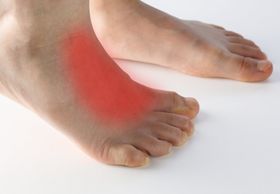How to Massage Your Plantar Fibroma
Updated July 28, 2025

Plantar fibroma is a swollen bump on the arch of the foot. It is a rare condition that affects the plantar fascia and can cause significant pain and pressure on the foot when standing or wearing shoes. Learn more about plantar fibroma and how to get rid of this condition by following a practical home massage technique.
Causes of Plantar Fibroma
While the exact cause of plantar fibroma is unknown, several factors have been identified as contributory in cases where a knot in the arch of the foot has been observed. Some of the most common are listed below:
- Trauma to the Plantar Fascia Injury to the plantar fascia often through overuse or repetitive stress can cause plantar fibroma.
- Genetics Plantar fibroma seems to be transmitted along familial lines so that you’re more likely to have it if someone in your family has previously had it.
- Medication Beta-blockers, anti-seizure agents, excess vitamin C supplements, and glucosamine/chondroitin medications can all trigger the formation of plantar fibroma.
Symptoms of Plantar Fibroma
There are no symptoms of plantar fibroma at the early stage. However, as the knot in the arch of the foot grows, it becomes more noticeable, causing pain and discomfort in the foot. It also causes pressure, especially when standing or wearing shoes.
Massaging Plantar Fibroma
While a physiotherapist can perform a plantar fibromatosis massage to relieve tension, you may also perform a home treatment to massage out a plantar fibroma. Consider doing this on yourself only after seeking expert advice from your doctor. Ensure you use proper technique when carrying out these massages. Some of the easiest and most common ways to perform a massage for plantar fibroma are:
- Golf ball massage While seated in a chair, place a golf ball in the arch of your foot. Gently roll the ball under your foot until you identify a pressure point. Press down until the pressure releases. Remember that pressure, not discomfort, is the goal.
- Petrissage massage of the foot This is a deep pressure massage to the sole. Using your thumb, work in a criss-cross manner from the heel to the ball of your foot until you cover the entire foot.
More Ways To Alleviate Symptoms of Plantar Fibroma
Orthotics These can be custom fitted to include an indent for the plantar fibroma. Thus, orthotics help redistribute the body weight, reduce the pressure on the heel and the tension in the plantar fascia. What's convenient is that with Upstep, you can order a custom orthotic online without ever needing to leave the comfort of your home.
» Discover the best insoles for plantar fibroma and much more
Physical Therapy The physiotherapist uses stretching, exercises, electrotherapy, shockwave therapy, and massage to treat plantar fibroma. The goal is to break down the tense fibers, improve circulation, and aid healing.
Conclusion: Massage and Physical Therapy for Plantar Fibroma
Undoubtedly, massage and other techniques used by physiotherapists are important in the management of plantar fibroma. Not only do they help in relieving pain; they also stimulate healing and help maintain the quality of life. However, the correct technique must be used. Thus, you must ensure you use massage (or any other treatment method) under the direct supervision or instruction of a physiotherapist or medical expert.








